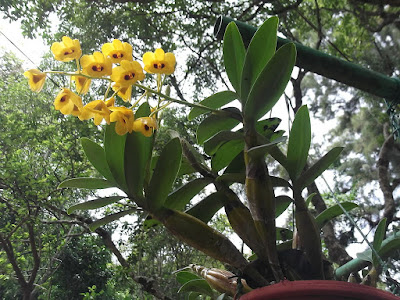Dendrobium chrysotoxum is widely distributed in Southeast Asia. Natural habitats extend from the Sikkim region in India through Assam, Burma, Thailand, Vietnam and Laos to the Yunnan Province in southwestern China. They grow at the altitude of 400-1620 m in the entire given area. In Thailand, plants are found near Chiang Mai, in deciduous forests above 610 m.
Dendrobium chrysotoxum, also called as The Golden Bow Dendrobium (refers to the inflorescence), Fried-egg Orchid, Callista chrysotoxa, Callista chrysotoxa, Callista suavissima Kuntze, Dendrobium chrysotoxum var. suavissimum, Dendrobium suavissimum, is a species of the genus Dendrobium. This species was described by Lindley in 1847.
IDENTIFY DENDROBIUM CHRYSOTOXUM
Dendrobium chrysotoxum is widely distributed in Southeast Asia. Natural habitats extend from the Sikkim region in India through Assam, Burma, Thailand, Vietnam and Laos to the Yunnan Province in southwestern China. They grow at the altitude of 400-1620 m in the entire given area. In Thailand, plants are found near Chiang Mai, in deciduous forests above 610 m.
It is a small sized, cool to warm growing epiphyte, which can reach the height of 10-30 cm, with clustered, grooved, clavate or fusiform, to 12" (30 cm) long, many angled, apically thickened pseudobulbs enveloped by many white, membraneous sheaths carrying 2 to 3 , towards the apex, oblong to lanceolate, coriaceous, acute, usually 10-18 cm long leaves.
The Golden Bow Dendrobium blooms from winter through spring from the 12" (30 cm) inflorescence arises from nodes near the apex of the pseudobulb and it is lax and pendulous and the flowers are highly fragrant of honey and are short lived. The flowers are 5 cm in diameter and are large in relation to the size of the plant. They have a golden to orange-yellow color, widely spread petals of the outer whorl and large, rounded petals of the inner whorl. The inner whorl flakes have slightly serrated edges. The almost round lip is curled, velvety and wavy. It has a curved orange or brown stripe and red stripes in the throat. The flowers have variable size and depth of color, and several varieties have their own names.
DENDROBIUM CHRYSOTOXUM CARE AND CULTURE
Cultural information should only be used as a guide, and should be to be adapted to suit you. Your physical location; where you grow your plants, how much time you have to devote to their care, and many other factors, will need to be taken into account. Only then can you decide on the cultural methods that best suit you and your plants.
Light:
Dendrobium chrysotoxum needs a light level of 25000-35000 lux. These plants adapt easily to specific conditions and can tolerate high levels of light, especially in the morning.
Temperature:
The average temperature of the summer day is 27-29 ° C, night 20 ° C, giving a daily difference of 7-9 ° C. In spring, the average day temperature is 31-32 ° C, the night 13-20 ° C, and the daily difference is 11-18 ° C. In winter the average day temperature is 25-29 ° C, night 10 ° C, giving a daily difference of 15-18 ° C.
Humidity:
The Golden Bow Dendrobium needs a humidity of 80-85% in summer and autumn, then it drops to 60% in the period of 2-3 months in winter and at the beginning of spring.
Substrate, growing media and repotting:
It is recommend to grow Dendrobium chrysotoxum in pots, because it helps to keep the right moisture in the summer. Any loose, fast drying substrate with granulation corresponding to the size of the plant can be used. They can also be mounted on tree-fern rootstocks or cork as long as there is high humidity and summer watering at least once a day. Repotting is best done in early spring, immediately after flowering, when new roots grow.
Watering:
From spring to early autumn, water is abundant, i.e. during the active growing season. During this period, Dendrobium chrysotoxum should be kept moist, with slight drying between watering. When new growths reach maturity in autumn, the amount of water should be gradually reduced.
Fertilizer:
These plants respond well to stronger fertilization, but excess mineral salts or too alkaline water can cause wilting and ultimately killing the plant. Weekly use of a 1/2 dose of orchid fertilizer is recommended. From spring to mid-summer, it is recommended to use high-nitrogen fertilizer, and then until the end of autumn, high phosphorus fertilizer.
Rest period:
A cool, dry rest is especially important for the Dendrobium chrysotoxum and should last until new growth appears in the spring. The high levels of light in winter are necessary to initiate flowering. Plants will grow healthier if for the majority of the winter they are allowed to dry out between waterings, but they can not stay dry for too long. However, for a period of 1-2 months at the end of winter, the plants should dry completely between waterings and stay dry longer. Occasional morning fogging between waterings will prevent excessive drying of plants. Fertilization should be very limited or eliminated until spring, when watering increases.















COMMENTS